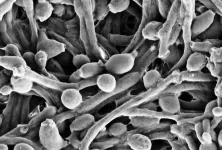(Press-News.org) A new study led by the U.S. Geological Survey outlines a means to better estimate COVID-19 occurrence and trends in populations.
Currently, COVID-19 testing is primarily limited to self-selected individuals, many of whom are symptomatic or have had contact with someone who is symptomatic. While these tests are useful for individual medical treatment and contact tracing, they do not provide health officials with a complete picture of the disease across the population.
"Coordinated sampling of COVID-19 is key to informing health officials as they continue their efforts to control the pandemic, permitting better predictions of disease dynamics and decisions that help limit transmission," said James Nichols, USGS scientist emeritus and lead author of the study. "The proposed sampling methods should also help officials determine the effectiveness of vaccines, social distancing, masks and other mitigation efforts."
By bringing its unique expertise in the design of data-gathering and monitoring systems, statistical analysis and mathematical modeling to human epidemiology, the USGS provides a means to fill the current information gap in testing data. This can benefit national and local governments and health officials as they develop interventions in response to new disease variants, plan for augmented vaccination efforts and prepare for future outbreaks.
With some countries experiencing surges in cases, Nichols points out, "the proposed testing strategies can be applied within the U.S. and internationally for COVID-19 and other diseases."
One proposal in the study is to select a random sample within a population and survey those individuals for symptoms, such as elevated temperature, in order to gather more representative data on asymptomatic cases. This would help researchers estimate the proportion of symptomatic and asymptomatic individuals in the population.
The asymptomatic individuals, or a random subset of those individuals, could be tested for COVID-19 to help estimate infection probability for asymptomatic individuals in the population.
"The strategies outlined in this new research would help strengthen current testing approaches and could be done with relatively few additional tests and non-invasive surveys," said Michael Runge, a USGS scientist and a co-author of the study. "Strategic testing, based on specific objectives, can provide information valuable for decisions about both individual healthcare and protecting communities."
"It is critically important to be clear about the goal of a surveillance program," said co-author Katriona Shea, a professor of biology and alumni professor in the biological sciences at Penn State. "Without knowing exactly what you want to achieve, how can you achieve it? A surveillance program for individual outcomes would be designed differently than a program aimed to understand population level public health objectives."
INFORMATION:
Partners with the USGS in this study include Penn State, Lancaster University, the U.S. Department of Agriculture, University of Oxford, Stellenbosch University, University of Warwick and the National Institutes of Health.
Read the article, published in PLoS Biology, online at https://journals.plos.org/plosbiology/article?id=10.1371/journal.pbio.3001307.
Antibiotic exposure early in life could alter human brain development in areas responsible for cognitive and emotional functions, according to a Rutgers researcher.
The laboratory study, published in the journal iScience, suggests that penicillin changes the microbiome - the trillions of beneficial microorganisms that live in and on our bodies - as well as gene expression, which allows cells to respond to its changing environment, in key areas of the developing brain. The findings suggest reducing widespread antibiotic use or using alternatives when possible to prevent neurodevelopment problems.
Penicillin and related medicines (like ampicillin and amoxicillin) are the most widely used antibiotics in ...
Scientists at Northwestern University in Evanston, Illinois have developed a hydrogel integrated with zirconium-based robust metal-organic frameworks (MOFs) that rapidly degrades organophosphate-based nerve agents used in chemical warfare. Unlike existing powdered MOF adsorbents, this hydrogel composite does not require added water and may be easily scaled up for use in protective masks or clothing. The work appears July 14 in the journal Chem Catalysis.
"Organophosphate-based nerve agents are among the most toxic chemicals known to humanity," says senior author Omar Farha, a professor of chemistry at Northwestern University. "Their use in recent global conflicts reflects the urgent need for personal protective gear, as well as the bulk destruction of ...
(Salt Lake City) - Bacteria's role in gut health has received a lot of attention in recent years. But new research led by scientists at END ...
BOSTON - New research in humans and mice identifies a particular signaling molecule that can help modify inflammation and the immune system to protect against Alzheimer's disease. The work, which was led by investigators at Massachusetts General Hospital (MGH), is published in Nature.
Cognitive decline associated with Alzheimer's disease develops when neurons begin to die. "Neuron death can be caused by improper immune responses and excessive neuroinflammation--or inflammation in the brain--triggered by high levels of amyloid beta deposits and tau tangles, two hallmarks of Alzheimer's disease," explains the paper's co-senior author Filip Swirski, PhD, who conducted the work while a principal investigator in the Center for Systems Biology at MGH. ...
BOSTON - Over the last decade, investigators at Beth Israel Deaconess Medical Center (BIDMC) have been at the forefront of the effort to END ...
New York, NY--July 14, 2021-- A previously unknown kind of human brain cell appears to help people center themselves in their personal maps of the world, according to a new study from neuroscientists at Columbia Engineering. This discovery sheds light on the cellular mechanisms underlying navigation and memory in humans, as well as what parts of the brain might get disrupted during the kinds of memory impairments common in neurodegenerative diseases such as Alzheimer's.
There are two strategies with which humans and animals navigate and orient themselves. One involves locating places, distances and directions in "allocentric" or other-centered ...
What The Study Did: The COVID-19 pandemic was associated with a decline in addiction treatment initiations but more research is needed to understand the cause of the decline in initiations and the extent to which it was due to reduced demand for services or reduced ability to supply treatment.
Authors: Tami L. Mark, Ph.D., M.B.A., of RTI International in Rockville, Maryland, is the corresponding author.
To access the embargoed study: Visit our For The Media website at this link https://media.jamanetwork.com/
(doi:10.1001/jamanetworkopen.2021.17029)
Editor's Note: The article ...
What The Study Did: In this randomized clinical trial, a physician messaging campaign was effective in increasing COVID-19 knowledge, information-seeking and self-reported protective behaviors among diverse groups.
Authors: Esther Duflo, Ph.D., of the Massachusetts Institute of Technology in Cambridge, is the corresponding author.
To access the embargoed study: Visit our For The Media website at this link https://media.jamanetwork.com/
(doi:10.1001/jamanetworkopen.2021.17115)
Editor's Note: The article includes conflict of interest and funding/support disclosures. Please see the article for additional information, including other authors, author contributions and affiliations, conflict of interest and financial disclosures, and funding and support.
# # ...
What The Study Did: About half the women experiencing homelessness and unstable housing who were surveyed experienced symptoms of depression or anxiety or both during the pandemic and, in addition to unmet subsistence needs and social isolation, these symptoms were associated with increased challenges accessing non-COVID-19 care and managing symptoms for chronic medical conditions.
Authors: Elise D. Riley, Ph.D., M.P.H., of the University of California, San Francisco, is the corresponding author.
To access the embargoed study: Visit our For The Media website at this link https://media.jamanetwork.com/
(doi:10.1001/jamanetworkopen.2021.17035)
Editor's ...
What The Study Did: This study found an unequal pattern of COVID-19 outcomes that was associated with the socioeconomic circumstances in regions of Japan, suggesting that these disparities in COVID-19 outcomes aren't unique to the United States and Europe.
Authors: Yuki Yoshikawa, M.D., M.P.H., of the Harvard T.H.Chan School of Public Health in Boston, is the corresponding author.
To access the embargoed study: Visit our For The Media website at this link https://media.jamanetwork.com/
(doi:10.1001/jamanetworkopen.2021.17060)
Editor's Note: Please see the article for additional information, including other authors, author contributions and affiliations, conflict of interest and financial disclosures, and funding and support.
# ...

